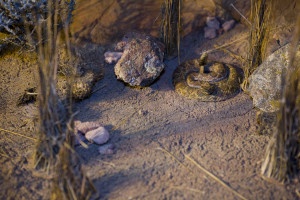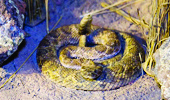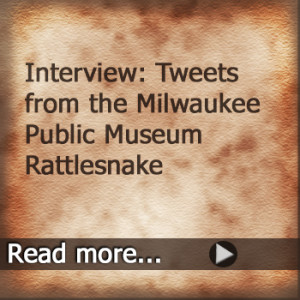 On the third floor of the Milwaukee Public Museum, there is a diorama display of a Great Plains buffalo hunt. Miniature men riding bareback on Palominos thunder across a dust-bunnied expanse of scrub brush and Styrofoam. The buffalo trample one another in their attempts to get away—they flee in freeze-frame motion, forelegs raised to leap the pebble-boulders and stick-logs. One buffalo has been singled out from the others and is steps away from plunging over the cliff. In its shoulder is a tiny arrow shot from a tiny bow, an immense pain driving it forward. Its red tongue lolls, and the whites of its eyes show around the pupils: bright pinpricks of fear visible all the way from the escalators. The flocked ground shakes and raises invisible dust. Acrylic clouds sweep across the walls.
On the third floor of the Milwaukee Public Museum, there is a diorama display of a Great Plains buffalo hunt. Miniature men riding bareback on Palominos thunder across a dust-bunnied expanse of scrub brush and Styrofoam. The buffalo trample one another in their attempts to get away—they flee in freeze-frame motion, forelegs raised to leap the pebble-boulders and stick-logs. One buffalo has been singled out from the others and is steps away from plunging over the cliff. In its shoulder is a tiny arrow shot from a tiny bow, an immense pain driving it forward. Its red tongue lolls, and the whites of its eyes show around the pupils: bright pinpricks of fear visible all the way from the escalators. The flocked ground shakes and raises invisible dust. Acrylic clouds sweep across the walls.
It is a fiercely exciting scene, this hunt, but it is not what we come to see. No, there is something else we look for here, past the kaleidoscope rotation of powwow dancers on permanent display, past the life-sized painted pony with the velvet rubbed off his nose. Just before the hallway leads us on to glass-plated scenes of the North American wilds, tucked away behind one of the plastic rocks that make up the barrier for the buffalo hunt diorama, there is a small button, smooth and cold to the touch and faintly greasy with generations of finger grime. The button is invisible, and to reach it you must crouch down, shoulder against the wall, and feel under the rock ledge, probing gently until you hit the abrupt metal lip.
There is no sign for the button. There has never been a sign for the button.
If you push it, something will happen: a few feet away in the diorama, coiled in the shade of a three-inch boulder, a minute rattlesnake flicks its tail. It vibrates with manic intensity. Under the bustle of museum noise—squeaky shoes on polished floors, stroller wheels, the escalator’s whoosh—you can hear the telltale rattle, a long hissing note.
Tiny hunters, be warned! Fangs lie in wait for you.
*
 I have known about the rattlesnake button for as long as I have been a visitor to the museum, a span of slightly over two decades. Inevitably, every trip included a push of the button, a joyous examination of the little rattlesnake’s tail, subsequently followed by the anguish of giving the button over to another impatient child. The rattlesnake button was as much a part of any museum visit as the dinosaur dioramas or the glass-plated boxes of pinned butterflies, beautiful and slightly sinister. But I cannot say precisely how I learned about it; perhaps my older brother or a friend on one of our many school field trips pointed it out. There was always something wonderful about the secrecy of this button, the special type of magic in knowing about a hidden machination, and should you find another child, a friend, who knew about it too, it was the quiet satisfaction of a secret society. Even better, though, was showing an unsuspecting friend or visiting cousin or feigning-ignorance parent the button. What an immense responsibility, that knowledge, and what pride from delighting a newcomer with that tiny, stirring rattle! I am far from my childhood but even now love to take any opportunity to introduce visiting friends to the rattlesnake button. Look here, I call, crouching by the rocks. Let me show you something cool.
I have known about the rattlesnake button for as long as I have been a visitor to the museum, a span of slightly over two decades. Inevitably, every trip included a push of the button, a joyous examination of the little rattlesnake’s tail, subsequently followed by the anguish of giving the button over to another impatient child. The rattlesnake button was as much a part of any museum visit as the dinosaur dioramas or the glass-plated boxes of pinned butterflies, beautiful and slightly sinister. But I cannot say precisely how I learned about it; perhaps my older brother or a friend on one of our many school field trips pointed it out. There was always something wonderful about the secrecy of this button, the special type of magic in knowing about a hidden machination, and should you find another child, a friend, who knew about it too, it was the quiet satisfaction of a secret society. Even better, though, was showing an unsuspecting friend or visiting cousin or feigning-ignorance parent the button. What an immense responsibility, that knowledge, and what pride from delighting a newcomer with that tiny, stirring rattle! I am far from my childhood but even now love to take any opportunity to introduce visiting friends to the rattlesnake button. Look here, I call, crouching by the rocks. Let me show you something cool.
On its own, it is a small thing—a little rattle, nothing more. But there is a thrill in showing it to someone, in sharing that knowledge. A thrill in watching, from a distance—perhaps lurking by the water fountains—as a child discovers that button: their shock, their pleasure. And in a way, this is, in microcosm, the experience of a museum, or perhaps the function of a museum on the smallest scale, for museums are living archives, architectural representations of a tradition of human knowledge and its transfer through generations. A museum is an accumulation of stuff—clay pots and fabric and mummies and food bits and taxidermied animals and things we’ve dug up from the ground—and this stuff, these objects are both physical and metaphorical. The arrowhead: the hunt, the care, and the dedication of the hunter. The crouching leopard: an apex predator and the fear of our ancestors. And the museum itself: that stuff and our attempt to record history and teach one another from it.
Come over here, we say. I want to show you something cool.
*
That button, then. A tradition passed from child to child. A hidden switch tucked out of sight and certainly out of mind. It must have a purpose, for why else would it be there? Buttons are meant to be pushed, after all. But why is there no indication of its existence? There is nothing obvious about it, and in fact, it serves no obvious purpose in an otherwise silent diorama; it provides no indispensable drama to the scene—the bloody hunt holds our interest on its own—adds no information, offers no extra dimension. It is useless in the grand scheme of the display, but still it exists.
Perhaps there are secret buttons everywhere in the world. Imagine a universe where under every end table is a spring that causes your water to bubble in its glass, or on page 374 of exactly this book on that shelf, there is a lever that will turn on the overhead light in the bathroom. It would keep you on your toes, this world of hidden buttons.
It strikes me as an uneasy proposition, in fact. To find them, you have to look, but that sort of vigilance—peeking behind doors, checking under stones—implies, at its worst, a type of paranoia and suspicion that things aren’t as they seem; it feels rather easy with this mindset to become the type of wild-eyed conspiracist we see staring at us from telephone-pole notices. Looking for things that have no reason to be there is, of course, a hallmark of madness, and I have never been predisposed to seeing signs and symbols in my tea leaves, being far too staunchly Midwestern to suspect the material world was hiding things from me.
But at its best, the value here might lie in learning to remain open to surprise, open to a world that contains all manner of rattlesnake buttons, as it were: useless oddities that exist in and of themselves, shy little things that do not boast of their presence but merely exist. This notion of objects’ value as objects seems very Victorian, but I think that it connects in a deep way to ideas of empathy and love. If we can respect objects as distinct physical presences—not sentient, merely distinct—that are not reflective of or responsive to us as humans, might we not be better able to afford dignity to one another? If we can allow that there are things that deserve existence, could we not turn this charity to ourselves, our neighbors? Through loving objects that do not serve us, could we better love each other? Finding joy in objects as object might be a way to rediscover pleasure in the subject: us.
This is a tall order, as our cultural narrative seems daily to move closer to overwhelming cynicism and a reactionary eye-roll stance; the thought of a secret shadow-world of bits and buttons strikes a chord perhaps too close to whimsy to not seem saccharine. Or, maybe, it leaves us vulnerable, and this we cannot stand. It is easier to be smugly superior about others’ disappointment than it is to have your hopes dashed, so why entertain any expectations, even the smallest?
And yet—that button. The tiny, whispering rattler. I have seen adults, teenagers, single retirees stepping in from the rain, go shifty-eyed, glance about, and mosey up to the wall to give the snake a run for its money. There is always a moment of hesitation before, shuffling their brochures and checking their IMAX ticket stub, they straighten up and leave.
We are never too old to be delighted by the shivery rattle of a miniature, papier-mâché snake.
*
Late one evening, I text my brothers to ask: do you remember the rattlesnake button? They both respond affirmatively, with just a hint of incredulity that I would even suggest they wouldn’t remember. But neither can tell me who told them about it or how they knew it was there. Our mother? they suggest. A teacher? I call up an old school friend and ask if she remembers, and she does. So cool, she gushes. She tells me about the first time she found it—she says “found it,” but when I prod, she admits she did not stumble onto it independently and must have been shown by another childhood friend—and how startled she was to hear the rattle, how fascinating it was to realize that she—she—was making the sound in the display. We talk about the diorama, different field trips we’d taken to the various wings of the museum, the particular quiet in the back rooms of the third floor, less traveled than other sections of the building. We grow quiet, thinking our separate thoughts.
But, my friend pauses, just now considering, why was the button even there? And we are back to the beginning again.
I realize that, with a few phone calls to museum staff, I could probably find the answer to at least one question: who made the button? But then I realize that I don’t want to know where the button came from. So much of the pleasure the rattlesnake button gives is in its secrecy, its absurdity, the uselessness of that object, that I fear attaching motivation to it would diminish it. I don’t want to see behind the curtain here because I fear the magic might not actually be magic at all, only a charlatan with his mind on practical matters like painting a diorama and putting up Styrofoam rock walls. And there is a little bit of selfishness there, too, since I don’t want to imagine that someone else holds the answer to this mystery; it’s both a communal pleasure and an isolated one. Secrets shared are no longer true secrets. So what we are sharing, then, is mystery.
Now that I’m an adult, I sometimes forego the pleasure of pushing the rattlesnake button and instead enjoy watching children find and push it; I have to hold myself back from telling strangers’ kids about it. But I want to, badly, because it’s a secret that is all the more enjoyable for telling it.
Come here and look. I want to show you something cool.
